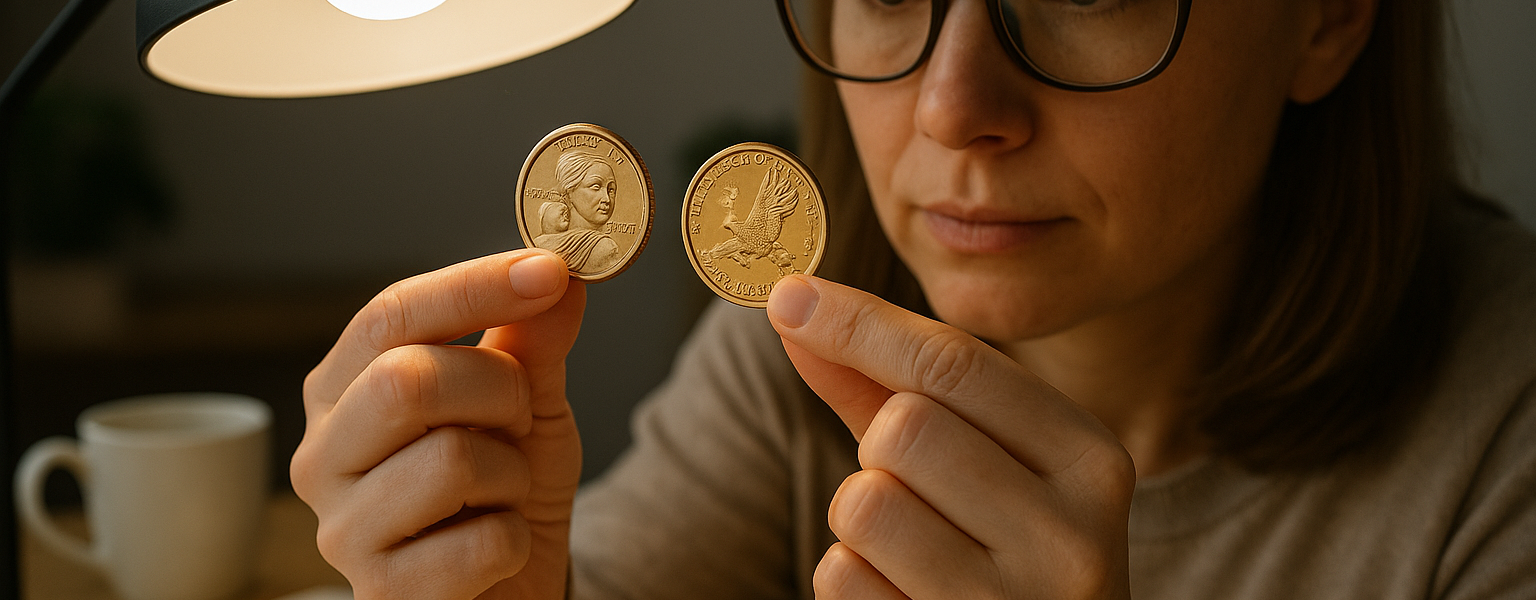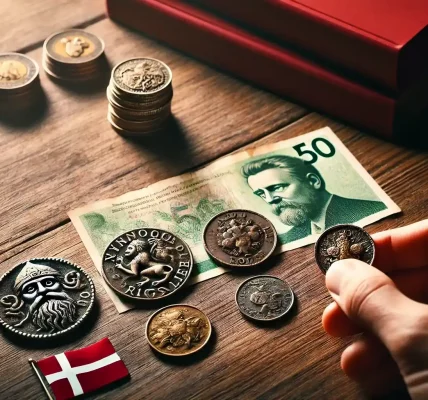The Sacagawea dollar has become one of the most studied modern U.S. coins. Collectors pay attention to its design, as well as to its rare varieties that changed the way people look at small-dollar issues.
Sacagawea dollar value depends on history, limited editions, and error varieties. That is why, here we review the rarest Sacagawea dollars, signs to identify them, and their current value.
Coin Overview and Main Characteristics
The Sacagawea dollar replaced the Susan B. Anthony dollar in 2000. It featured a new design to commemorate a Native American woman who guided the Lewis and Clark Expedition.
| Feature | Description |
| Year of issue | 2000 – present |
| Designer | Glenna Goodacre (obverse), Thomas D. Rogers Sr. (reverse) |
| Composition | 88.5% copper, 6% zinc, 3.5% manganese, 2% nickel |
| Weight | 8.1 g |
| Diameter | 26.5 mm |
| Edge | Plain |
| Mint marks | P (Philadelphia), D (Denver), S (San Francisco Proof) |
| Theme | Sacagawea carrying her son Jean Baptiste; eagle reverse |
The bright gold color comes from its manganese-brass alloy, not from gold. Despite limited use in circulation, the coin became a collectible because of its design, durability, and later, the discovery of rare error varieties.
Collectors focus mainly on early 2000 issues and special strikes that differ slightly from normal circulation pieces.

Historical Context — From Anthony to Sacagawea
By the end of the 1990s, the U.S. Mint had a goal to redesign the dollar, as the Susan B. Anthony coin was not popular. Design with Sacagawea was chosen for her historic role as guide and interpreter during the Lewis and Clark Expedition.
Main points for collectors:
- Early 2000 bank rolls may still contain rare variants.
- Always check the eagle’s tail feathers and edge for differences.
- Promotional programs like Cheerios packs distributed a small number of rare early pieces.
Even though the dollar failed to replace paper money, it became a popular modern issue.
Rare and Valuable Sacagawea Dollar Varieties
Not every Sacagawea coin is rare. Some versions became valuable because of minting mistakes, promotional use, or limited presentation. These special varieties form the main collector interest.
Types of rarity:
- Promotional or presentation issues such as Cheerios and Goodacre coins.
- Major minting errors like Wounded Eagle or Mule varieties.
- Modern anomalies including edge lettering and planchet mistakes.
Some of the most valuable pieces you can see below.
2000-P “Cheerios” Sacagawea Dollar
One of the most famous modern U.S. rarities. About 5,500 coins were placed in Cheerios cereal boxes in 2000 as a promotion. These early strikes were made with a prototype reverse die that shows sharper and fuller tail feathers on the eagle.
Why valuable:
- Limited mintage and unique design details.
- Most coins remain sealed in original packaging.
- Certified examples sell from $4,000 to $10,000, with MS68 pieces reaching up to $12,000.
Collector tip: Keep Cheerios dollars in unopened packages or sealed holders. Use angled light to compare the tail feathers — prototype pieces have sharper feather lines than normal issues.
2000-P “Wounded Eagle” (Speared Eagle) Sacagawea Dollar
This variety appeared when a die defect left a raised diagonal line across the eagle’s chest. The error is visible to the naked eye and looks like a spear or scratch. Cataloged as FS-901, it was struck in Philadelphia.
Market value (2025):
- MS63: around $150–$250
- MS65: $300–$450
- MS67+: $1,000–$1,200
How to identify: Check the coin under bright light — the line crosses the bird’s chest toward the wing. Unlike damage, the line is raised, not cut into the surface.
This “Wounded Eagle” became one of the first popular modern mint errors and is still actively hunted in unopened 2000 Mint rolls.
2000-P / State Quarter Mule Error
The rarest Sacagawea dollar ever produced. The obverse shows George Washington from a state quarter, while the reverse is the standard Sacagawea design. This error happened when a quarter obverse die was mistakenly paired with a Sacagawea reverse. All known examples were struck in Philadelphia.
Value:
- Auction records range from $80,000 to $150,000.
- A single specimen sold for $194,062.50 (including Buyer’s Premium) at GreatCollections.
- Fewer than 20 examples are known.
Collector note: Each verified coin is certified by PCGS or NGC. Any raw example should be authenticated before sale, as counterfeits exist. For collectors, this coin is the crown jewel of the Sacagawea series.
2000-P “Goodacre Presentation” Sacagawea Dollar
In 2000, the Mint gave sculptor Glenna Goodacre 5,000 specially finished coins as payment for her obverse design. They have a distinctive satin-like appearance known as “presentation finish”.
Market value:
- Certified examples: $400–$800
- Prooflike surfaces and full documentation raise the price further.
How to recognize: Goodacre coins show soft luster, not the mirror shine of proof coins or the bright polish of circulation strikes. Each certified piece carries a “Goodacre Presentation” label from PCGS or NGC.
2007-D Sacagawea Dollar with Presidential Dollar Edge Lettering Error
A rare hybrid error. During 2007, the Denver Mint struck some Sacagawea dollars on presses meant for Presidential $1 coins. As a result, these pieces received the wrong edge lettering with “In God We Trust” and “E Pluribus Unum”.
Value:
- MS65: $1,000–$2,000
- MS67+: up to $3,000
Tip: Check the edge lettering with side lighting — only these hybrids show raised inscriptions, while all normal Sacagawea coins have plain edges.
Other Known Sacagawea Dollar Errors
In addition to well-known rare varieties, there are also more typical errors. They are not as expensive, but are still worthy and can add to the value of a coin. Below are the most common minting flaws on the Sakagawa dollar and their approximate value.
| Error Type | Description | Typical Range | Notes |
| Off-center strike | Part of design missing or shifted | $80–$250 | Dramatic examples >25% are most valuable |
| Doubled die (DDO/DDR) | Letters or numbers show doubling | $100–$300 | Found on 2009–2010 issues |
| Lamination error | Surface layer peeling or flaking | $50–$150 | Result of planchet flaw |
| Wrong or clipped planchet | Struck on wrong or incomplete blank | $500–$5,000+ | Rare, sometimes on quarter planchets |
Collector checklist:
- Verify weight and diameter before buying.
- Look for clipped edges or unusual toning.
- Do not clean or polish errors — any surface change lowers their market grade.
How to Identify, Verify, and Track Your Coins
Proper examination helps avoid confusion between genuine errors and damage.
Practical inspection steps:
- Use a 5×–10× magnifier and neutral lighting.
- Hold coins by the edges only.
- Compare your piece with reference photos from the U.S. Mint archives or other trusted sources like PCGS or NGC guides and so on.
- Store coins in acid-free holders or capsules to prevent oxidation.
Digital help: Apps like Coin ID Scanner allow collectors to recognize a coin by photo, showing its year, mint mark, and approximate market range. The app also helps catalog personal collections and track changes in value over time.

Market Overview — How Value Changes Over Time
Rare Sacagawea coins show stable demand among collectors. While common issues remain close to face value, special varieties and certified errors hold strong market positions.
| Variant | Typical Value (2025) | Premium Range | Notes |
| Cheerios Dollar | $4,000–$10,000 | MS68+ up to $12,000 | Early release with prototype die |
| Wounded Eagle | $250–$1,200 | — | Clear die defect, limited supply |
| Mule Error | $80,000–$150,000 | — | Rarest modern U.S. dollar |
| Goodacre Presentation | $400–$800 | — | Distinct satin finish, signed provenance |
| 2007-D Edge Error | $1,000–$2,500 | — | Hybrid edge lettering variety |
Market observations:
- Cheerios and Mule coins remain the top varieties.
- Proof and certified versions show slower but steady growth.
- Market values vary based on grade, certification, and demand cycles.
Collector tip: Focus on condition first. An average coin in MS67 can be worth ten times more than the same issue with visible wear.
Why These Dollars Still Matter
The Sacagawea $1 coin is still a symbol of innovation and diversity of U.S. coinage. Even though it never replaced paper money, it brought new technology and design detail to modern mints. For collectors, these coins combine historical meaning with realistic market potential. The rare versions, from the Cheerios prototype to the Mule error, continue to define what modern collectors are looking for.









